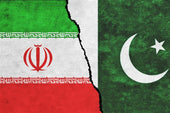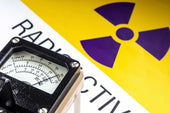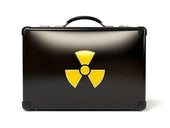The world quickly changed after the atomic bombing of Hiroshima from a "post-War" to a "pre-SIOP" era.
Because the history of nuclear weapon development, strategy, and policy is so large and complex, it would take several books to adequately detail it.
Since 1945, U.S. nuclear strategy and doctrine have changed in response to shifts in both U.S. and Soviet nuclear capability.
Deterrence is a tricky idea. Dr. Strangelove defines deterrence as "the art of producing in the mind of the enemy... the fear to attack." The word deter comes from the Latin root deterre, which means "to frighten from" or "to turn aside, discourage, or prevent from acting."
Nuclear Deterrence Policy
The United States has implemented a deterrence strategy concerning the possibility of nuclear war.
These goals are part of American nuclear policy:
-
Maintain effective deterrence: Whatever the attacker's goals, an effective deterrent ensures that no situation would make the aggressor believe it could successfully attack the United States or its allies.
-
Support strategic stability: Strategic stability is when no nation is forced to deploy nuclear weapons first.
-
Maintain the ability to respond flexibly to an attacker's attack: Maintaining deterrence demands the ability to respond in a way that, no matter the situation, prevents an attacker from achieving their goals.
Since 1961, American policy's mainstay has been preserving flexibility in U.S. forces and programs.
The U.S. Strategic Nuclear Forces

The U.S. strategic nuclear forces are the foundation of the flexible response strategy. At all escalation levels, the threat of their deployment provides authority to U.S. strategy.
In addition to addressing the Soviet threat, the initiative to update all three components of the U.S. nuclear force structure aims to safeguard the country against the developing danger of spreading chemical and nuclear weapons technology to other nations.
The American nuclear force organization's three pillars triad consists of bombers and land- and sea-based ballistic missiles.
The modernization program includes modernizing strategic offensive forces, enhancing command, control, and communications capabilities, implementing arms control measures, and introducing strategic defensive initiatives. It considers the possibility that traditional conventional and nuclear deterrence may not be sufficient.
The following are included in the strategic arsenal:
-
1,000 land-based intercontinental missiles with 2,450 warheads
-
592 submarine-launched ballistic missiles with 5,056 warheads
-
293 strategic bombers will deliver 5,820 bombs and warheads
The Strategic Arms Reductions Treaty between the United States and the Soviet Union, signed on July 31, 1991, would eventually decrease the United States deployed strategic arsenal to 6,000 responsible warheads, according to a DOD (Department of Defense) official.
The Atlantic, Pacific, and Strategic Air Commands are the three U.S. commands with strategic nuclear weapons. The annual force-level commitments in the Single Integrated Operational Plan (SIOP) must be made by the Commanders-in-Chief (CINCS).
The Single Integrated Operational Plan (SIOP)
The U.S. has established a coordinated strategy to use nuclear weapons. This process has changed from the first atomic weapon usage on August 6, 1945, to the present.

What is SIOP?
In the event of war, American nuclear weapons would be employed following the Single Integrated Operational Plan or SIOP.
The President's conceptual structure serves as the foundation for the SIOP. The Secretary of Defense transforms the manual into the Nuclear Weapons Employment Policy (NUWEP), which contains the fundamental target lists, objectives, and operational restraints.
Afterward, the NUWEP is given to the Joint Chiefs of Staff (JCS), from which the Joint Strategic Capabilities Plan (JSCP) is born.
The SIOP, which contains the actual targeting commands, timing, and weapon allocation, is STRATCOM's first plan from the JSCP. The process can take up to 18 months to complete.
When President Clinton was in office, the SIOP had four major attack choices, 65 restricted attack options, and several generalized adaptation options for threats from countries other than Russia or China.
Process Used in Developing the Single Integrated Operational Plan
President Eisenhower appointed the CINC of the Strategic Air Command as the Director of Strategic Target Planning, establishing the fundamental framework for decision-making.
The Director created a National Strategic Target List and a SIOP for a coordinated assault on various target sets within the Soviet Union, China, and their allies.
A newly formed JSTPS was tasked with creating the target list and SIOP under the direction of the Joint Chiefs of Staff and with the consent of the Secretary of Defense.

Step 1: Guidance from the President
The strategic nuclear-targeting policy is typically reviewed when a new government and other national security goals are in place.
The President determines the U.S. strategy after a coordinated study by the National Security Council. Over the years, Several National Security Decision Directives or Memoranda have been issued, providing the Department of Defense with presidential direction regarding the use of nuclear weapons. The advice offered has progressively evolved and is often rather general.
The 1960s saw the most significant policy shift, as the focus was switched from harsh reprisal to adaptable response. In the case of an assault against the United States or its allies, significant retaliation left the President with only two choices: take no action or launch a massive counterattack.
The goal of the flexible reaction was to give the President alternatives for various actions that would aim to end the war before it escalated into a full-scale nuclear conflict.
The present nuclear weapons employment policy is outlined in a National Security Decision Directive that President Reagan released in November 1981.
Shortly after assuming office in January 1989, President Bush reiterated similar instructions. The following are included in this instruction:
-
the requirement for a range of attack options
-
the types of forces desired
-
general targeting objectives
-
broad categories of targets
-
the requirement for survivable command, control, and communications systems
-
the requirement for a secure reserve force
Step 2: Guidance from the Secretary of Defense
The Joint Staff and the Office of the Assistant Secretary of Defense for International Security Policy work together to develop the Department of Defense's (DOD) Nuclear Weapons Employment Policy (NUWEP).
Representatives from the Office of Strategic Forces Policy, International Security Policy, and the Joint Staff use guidance from the President to prepare and update NUWEP.
The most frequent reason for revisions is to reflect changes in the threat when the nuclear weapons employment policy is internally reviewed. Additionally, the President is alerted to any significant modifications to the NUWEP. The NIJWEP offers comprehensive advice on
-
basic planning assumptions
-
attack options
-
targeting objectives
-
types of targets within various categories
-
targeting constraints
-
coordination with theater commanders
Planning assumptions provide the following guidance:
-
range of attack options to provide the President with flexibility in responding to an attack upon the United States or its allies, both major and small attack options
-
relationships between certain types of weapons and certain types of targets
-
statements of what not to assume in preparing operational war plans (for example, do not assume that communications will be perfect).
Step 3: Guidance from the Chairman, Joint Chiefs of Staff
The Joint Staff's Strategic Plans and Policy Directorate creates Nuclear of the Joint Strategic Capabilities Plan (JSCP) with assistance from the CINC and service staff utilizing NUWEP.
It is formally updated every two years, giving the CINCS the most recent instructions for using strategic and non-strategic nuclear weapons. In addition to other topics, the.JSCP offers advice on the following:
-
the requirement for plans for specific employment options
-
the requirement for a secure reserve force
-
damage criteria to be used for targeting
Step 4: The Single Integrated Operational Plan
The SIOP is the United States' war plan for using strategic nuclear operations.
Plans and choices for attacks are included in the SIOP, which reflects the targeting advice given by JSTPS.
These options are made to comply with political directives and to destroy adversary military or industrial installations at the required level of intensity.
Unexpected adjustments to U.S. strategic forces, the target base, or direction could occur while the plan operates.
Minor modifications are integrated into the SIOP, but more substantial changes to the force structure, target, or guidance are implemented into the next SIOI.
According to representatives of International Security Policy, incorporating them into the current SIOP would be too disruptive and may render the strategy "unworkable."
In the past, adjustments were primarily the result of modifications to the target base or the U.S. strategic forces. Recent updates to the targeting advice necessitated changes to the SIOI'.
The creation of a SIOP takes roughly 18 months, and it is divided into the following three stages:
-
Targeting: identification of specific targets and the allocation of weapons.
-
Application: assignment and deconfliction of missions.
-
Analysis: determination of projected damage.
The targeting and analysis phases overlap with the application phase. While the new SIOI development process is underway, the current SIOP is also periodically maintained. During these maintenance cycles, immediate and minor changes can be made.
The 9/11 and the Formulation of the "War Plan" Series
The Clinton administration's nuclear war plan sparked widespread doubt after it was made public by the media and academics.
In one of his addresses at the National News Club in 2000, George W. Bush, then a presidential candidate, accused the Clinton administration of "still being involved in the Cold War." Bush pledged that if elected President, he wouldn't base nuclear weapon deployment decisions on the possibility of a nuclear conflict (by designating Russia and China as the targets).
The U.S. government was under intense domestic and international pressure at the time to reduce its nuclear arsenal. Therefore, Bush's address was primarily intended to appeal to the general population.
Bush's efforts to "get rid of the Cold War mentality" in the U.S. strategic war plan didn't take effect until just before he left office.
Whether the 8010-08 war plan, which was eventually renamed the Strategic Deterrence and Global Strike, will genuinely give up the Cold War mindset and whether this will be useful for reducing U.S. nuclear weapons remains to be seen.
Changes due to the 9/11 attack

The 9/11 terrorist attacks in 2001 forced the Bush administration to change the rigid U.S. nuclear war plan. These attacks made U.S. decision-makers aware that "non-state actors today could use relatively cheap and commercially available technologies to attack distant targets."
Before 9/11, the United States also faced the threat of terrorism, especially during the Clinton administration, although terrorism had never posed a significant threat to the country's national security.
Since 9/11, dealing with crises and unplanned events has become central to national security in the United States.
Because of this, adaptability—which seeks to prevent every emergency and unplanned event—is the route for future adjustment. Flexibility was no longer sufficient for a U.S. nuclear war plan geared at strategic deterrence.
A 2002 Nuclear Posture Review, which the media made public, revealed details of the Bush administration's change in nuclear employment policies.
The United States would make significant changes to the target countries of the strategic nuclear strike as they were "getting rid of the old large scale and comprehensive concept of SIOP and developing a plan with more flexibility and adaptability."
The OPLAN 8044
Starting with the SIOP's name change, the Bush administration made a significant and thorough overhaul.
As a result of numerous requests from the U.S., SIOP for Strategic Command was finally changed to OPLAN 8044.
The name change is significant from two viewpoints in particular:

The Bush administration revised its strategy yet again. OPLAN 8044 now has at least two iterations, "the 2003 fiscal year edition" and "the 2005 fiscal year edition."
However, the final adjustments to the placement targets, striking strategies, and SDP principles were made under OPLAN 8010-08.
Evidence suggests that the biggest difference was the combination of strategic threats and a worldwide strike in OPLAN 8010-08. The SDP task from the Cold War era continues through strategic threats.
The 8010-08 Strategic Plan, according to Hans M. Kristensen, a renowned academic who has been closely monitoring the U.S. nuclear war strategy, may have been the first non-SDP plan.
He added that, although some conventional strike components are present, "the nuclear strike task is overwhelmingly important."
OPLAN 8010 formally includes pre-emption and even nuclear strikes against nations without nuclear weapons as one of its two cornerstones.
American academics published a "Joint Nuclear Operation Command" as early as 2005, demonstrating that OPLAN 8044 had already recommended preventative measures against nations with WMDs and terrorist organizations.
OPLAN 8010 has caught on to this change and launched a global strike.
Therefore, besides nuclear powers like Russia or China and nuclear-free nations like Iran and the DPRK, various non-national entities and terrorist groups are also targeted by U.S. strategic objectives.





















































